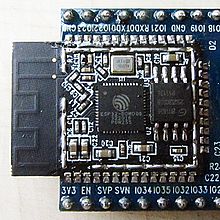ESP32
The ESP32 is an inexpensive and running low-power 32-bit - microcontroller family of the Chinese company espressif which was launched in the 2016th With their open design, the microcontrollers enable the construction and networking of network-based actuators and sensors . The GNU Compiler Collection including tool chain is available as a free development tool .
The processors consist internally, depending on the type, of one or two processor cores of the type Xtensa LX6 from Tensilica and work with a system clock of 160 MHz - 240 MHz. The internal RAM memory has a size of 160 KiB static allocated + 160 KiB dynamically allocated DRAM, combined with an internal read-only memory (ROM), which contains an unchangeable bootloader . Like its predecessor ESP8266 , most models from the ESP32 family do not have an internal flash memory for the application-specific firmware . This is stored in an external, serial flash memory, which is connected to the processor via dedicated connection pins.
The ESP32 family has various peripheral interfaces, including several UARTs , SPI , CAN and I²C interfaces, an integrated wireless local area network (WLAN according to IEEE 802.11 b / g / n) which also supports Bluetooth , and an Ethernet Interface is available via the Media Independent Interface (MII). Analog-to-digital converters and digital-to-analog converters for processing analog signals and built-in sensors, such as an integrated Hall sensor for measuring the magnetic flux density , are provided as analog interfaces . Internally, the ESP32 has a cryptographic unit for hardware-supported acceleration of encryption processes such as the Advanced Encryption Standard (AES) and a coprocessor with low power consumption, which, in addition to a real-time clock, also allows the query of sensor data in standby mode.
The processors are housed in the Quad Flat No Leads Package (QFN) chip housing with 48 pins (size: 6 mm × 6 mm) and are usually sold on small modules under names such as ESP-WROOM . In addition to the processor and a serial flash memory for the firmware, these semi-finished circuit board modules also include the WLAN antenna and a power supply and thus allow simple applications, for example in the context of hobby electronics . A software development kit (SDK) from the manufacturer is available for software development under MIT license, as well as various development platforms such as Arduino , MicroPython , NodeMCU or Lua RTOS .
Web links
Individual evidence
- ^ Espressif Announces the Launch of ESP32 Cloud on Chip and Funding by Fosun Group. September 16, 2016, accessed June 22, 2018 .
- ↑ Heap Memory Allocation ( English ) Espressif Systems. Archived from the original on July 14, 2019. Retrieved September 3, 2019.
- ↑ ESP32 Datasheet Version 2.3. Retrieved June 22, 2018 .
- ↑ Big brother: Espressif ESP32. heise online, accessed on June 22, 2018 .
- ↑ Espressif Systems - Github. Retrieved June 22, 2018 .
- ↑ Lua RTOS for ESP32. Retrieved June 22, 2018 .
